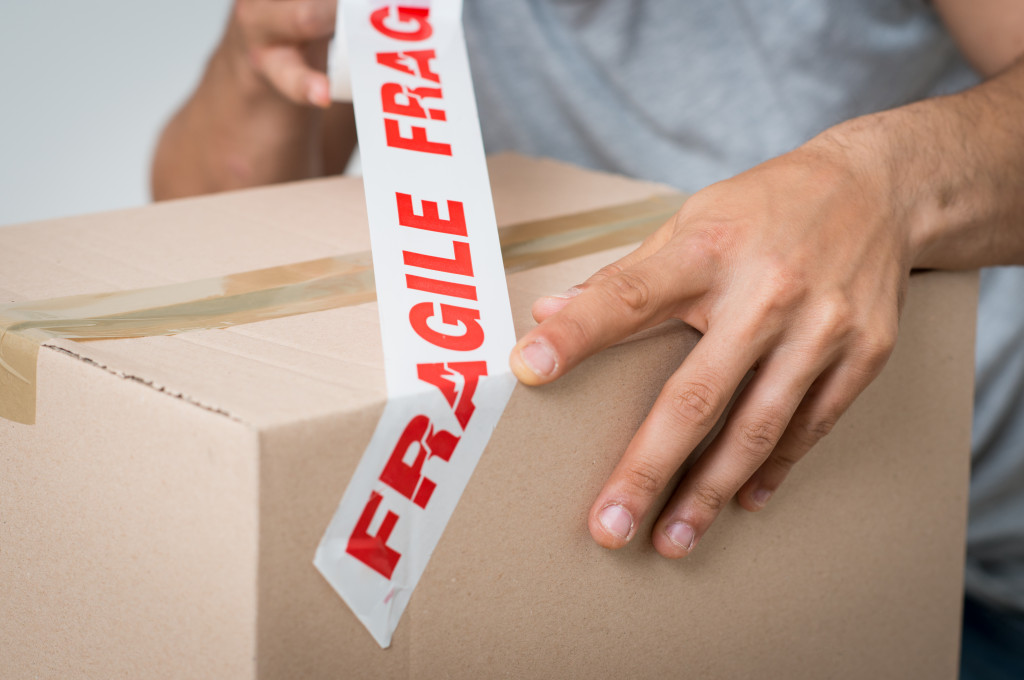- Use high-quality materials such as foam, bubble wrap, and air pillows for packaging fragile items securely.
- Utilize labels like “Fragile,” “Handle with Care,” and “Do not Drop” to alert carriers of the package’s fragility.
- Select the right shipping method for your goods, taking into account its ability to handle fragile items and coverage options.
- Avoid overpacking, as it can strain sensitive goods during transit leading to damage.
When sending fragile packages, the feeling of unease can be palpable. Worrying about whether your items will arrive in good condition can cause great stress, especially considering the high cost of replacing or repairing damaged goods. As a business owner or carrier, you will want to minimize the risk of damaged goods as much as possible. Luckily, there are many steps you can take to protect your fragile packages during transit.
Kinds of Fragile Packages
When shipping fragile items, it’s important to understand the kinds of packages that you are dealing with. First, determine if the package is static or dynamic.
Static Packages
Static packages are items that can’t move around. These packages usually require extra cushioning and protection, so they don’t experience any shifting during transit. Examples of static packages include glassware, ceramics, and sculptures.
Dynamic Packages
Dynamic packages are those that can move around in their package during transport. Examples of dynamic packages include electronics and other light items. For these packages, it is important to ensure they don’t have too much room to move around in their packaging, as this can lead to damage.
Packing Securely
Regardless of the package type, you must ensure it is packed securely. After all, customer satisfaction and reputation depend upon it. Below are some tips for getting packages ready for transit.
Choose the Right Packaging Materials
The first step in protecting your fragile goods starts with the packaging materials you use. Always use high-quality materials like foam, bubble wrap, or air pillows. These materials provide cushioning and absorb shocks during transit. Consider double-boxing fragile items and using heavy-duty tape to secure the packages.
Label Your Packages Correctly
Proper labeling of your packages can help alert carriers to the fragile nature of the goods. Use labeling such as “Fragile,” “Handle with Care,” or “Do not Drop” to help ensure that carriers take extra caution when handling your packages. Ensuring these labels are placed in visible locations on the packaging is essential.

Custom Containers
Another great way to protect fragile packages is by using custom transportation containers. These custom solutions are designed to provide maximum protection for delicate items in transit. They can also help prevent any item shifting during transport, which ensures your items arrive undamaged. These containers are usually made of wood, foam, or other materials and can be customized with your branding.
Select the Right Shipping Method
Picking the right shipping method is crucial for the safety of your fragile items during transit. Inspect the shipping company’s ability to handle fragile goods, rates, and coverage options. Select the shipping method that best matches your requirements. Your best bet is a shipping option with specialized services that take extra care in handling fragile goods.
Avoid Overpacking
While you may be tempted to add more packaging for extra protection, overpacking can lead to more issues than it solves. Overpacking can increase the weight and size of the package and, in turn, lead to additional stress and pressure on sensitive goods during transit, leading to more damage.
Insure Your Shipments
Consider insuring your shipments. Insurance coverage provides added protection and peace of mind during transit. Insurance can also provide coverage for any natural disasters or other unforeseen events. Work with your carrier to identify the appropriate insurance option for your shipment’s value and nature.
Practices to Avoid

While there are many practices to ensure the safe transit of your fragile packages, some practices must be avoided. Here are the top things to avoid when shipping fragile packages:
- Reusing old packaging materials: These are usually not strong enough to protect fragile packages adequately. Examples of materials to avoid include newspapers, cardboard, and plastic bags.
- Securing packages with cords or ropes: This can put extra strain on the package and cause damage to the contents.
- Using excessive cushioning- Too much cushioning can strain the package unnecessarily, leading to damage.
- Avoid cheap packaging materials: Low-quality packaging materials can be more damaging than helpful. Cheap bubble wrap, cardboard boxes, and other materials are insufficient protection during transit.
- Don’t use styrofoam peanuts: Though they may seem cost-effective, they don’t provide enough cushioning for fragile items and can cause more damage.
Shipping fragile items can be nerve-wracking, but by taking the right steps to ensure their safe transit, you can rest assured that your packages will arrive safe and sound. Following the tips outlined above will help protect your fragile goods during transit and ensure customer satisfaction. By utilizing these strategies, you can shop confidently, knowing your items are in good hands.



